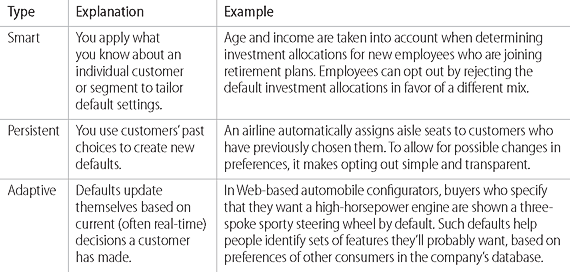Nudge Your Customers Toward Better Choices
The Idea in Brief
A car rental agency includes insurance unless you specifically decline it. A software vendor recommends clicking "next" for a quick install. These companies have designed defaults for customers.
Well-designed defaults simplify decision making, enhance customer satisfaction, and drive profitable purchases--benefiting companies and consumers. Ill-conceived defaults can backfire. When Facebook began displaying members' purchases by default, users screamed "Privacy invasion!" and launched a class action lawsuit.
Defaults have strategic importance, so don't leave them to programmers or forms designers, say Goldstein and his coauthors. To design effective defaults, understand which types to use when. For example:
If you expect most of your customers would prefer a basic product or service configuration, use a mass default. Online retailers' standard shipping default is an example.
If you think customers would value options tailored to their preferences, use a personalized default. For instance, a hotel makes nonsmoking rooms the default for guests who requested them before.
The Idea in Practice
Mass Defaults
These generic defaults are useful when the majority of customers prefer one basic product or service configuration or can benefit from standardized recommendations (for example, the default ensures maximum safety). If you lack information about customers' preferences, mass defaults may be your only option.
Personalized Defaults
These capitalize on your knowledge about customers and can be tailored to better meet their needs.
Further Reading
Articles
Understanding Customer Experience
Harvard Business Review
February 2007
by Christopher Meyer and Andre Schwager
Anyone who has signed up for cell phone service, attempted to claim a rebate, or navigated a call center has probably suffered from a company's apparent indifference to what should be its first concern: the customer experiences that culminate in either satisfaction or disappointment and defection. Many executives don't appreciate how analysis of customer experience differs from CRM or just how illuminating the data can be. For instance, the majority of the companies in a recent survey believed they have been providing "superior" experiences to customers, but most customers disagreed. The authors describe a customer experience management (CEM) system that helps companies discover which customers are prospects for growth and which require immediate intervention.
Harvard Business Review
April 2005
by Ranjay Gulati and James B. Oldroyd
Companies have poured enormous amounts of money into customer relationship management, but in many cases the investment hasn't really paid off. That's because getting closer to customers isn't about building an information technology system. It's a learning journey that begins with the creation of a companywide repository containing every customer interaction with the company, organized by customer. During the first stage, each group contributes its information to the data pool and then taps into it as needed. In the second stage, one-way serial coordination from centralized analytical units out to the operating units allows companies to go beyond just assembling data to drawing inferences. In stage three, information flows back and forth between central analytic units and various organizational units like marketing, sales, and operations, as together they seek answers to questions like "How can we prevent customers from switching to a competitor?" and "Who would be most likely to buy a new product in the future?" In stage four, firms bring an integrated understanding of their customers to bear in all day-to-day operations.
Companies and the Customers Who Hate Them
Harvard Business Review
June 2007
by Gail McGovern and Youngme Moon
Why do companies bind customers with contracts, bleed them with fees, and baffle them with fine print? Because bewildered customers, who often make bad purchasing decisions, can be highly profitable. Most firms that profit from customers' confusion are on a slippery slope. When a rival comes along with a friendlier alternative, customers defect. Adversarial value-extracting strategies are common in such industries as cell phone service, retail banking, and health clubs. Overly complex product and pricing options, for example, may have been designed to serve various segments. But in fact they take advantage of how difficult it is for customers to predict their needs (such as how many cell phone minutes they'll use each month) and make it hard for them to choose the right product. Similarly, penalties and fees, which may have been instituted to offset the costs of undesirable customer behavior, like bouncing checks, turn out to be very profitable. As a result, companies have no incentive to help customers avoid them. Tactics like these generate bad publicity and fuel customer defections, creating opportunities for competitors. Companies that dismantle these harmful practices and design a transparent, value-creating offer can head off customer retaliation and spur rapid growth.
- Purchase the full-length Harvard Business Review article here.
- Visit Harvard Business Online.
- See more on Strategy and Execution at Harvard Business Online.
Copyright (c) 2008 Harvard Business School Publishing Corporation. All rights reserved.

